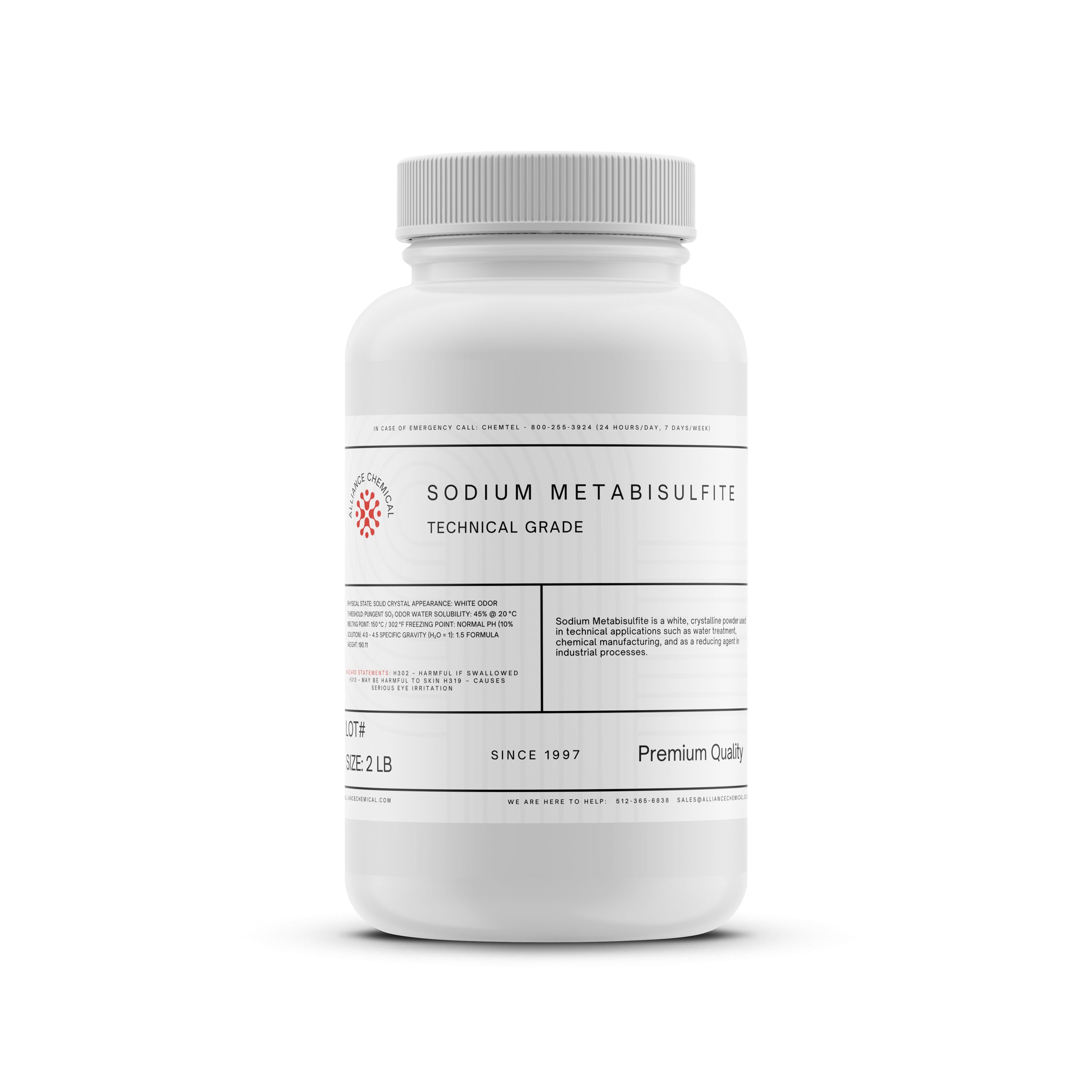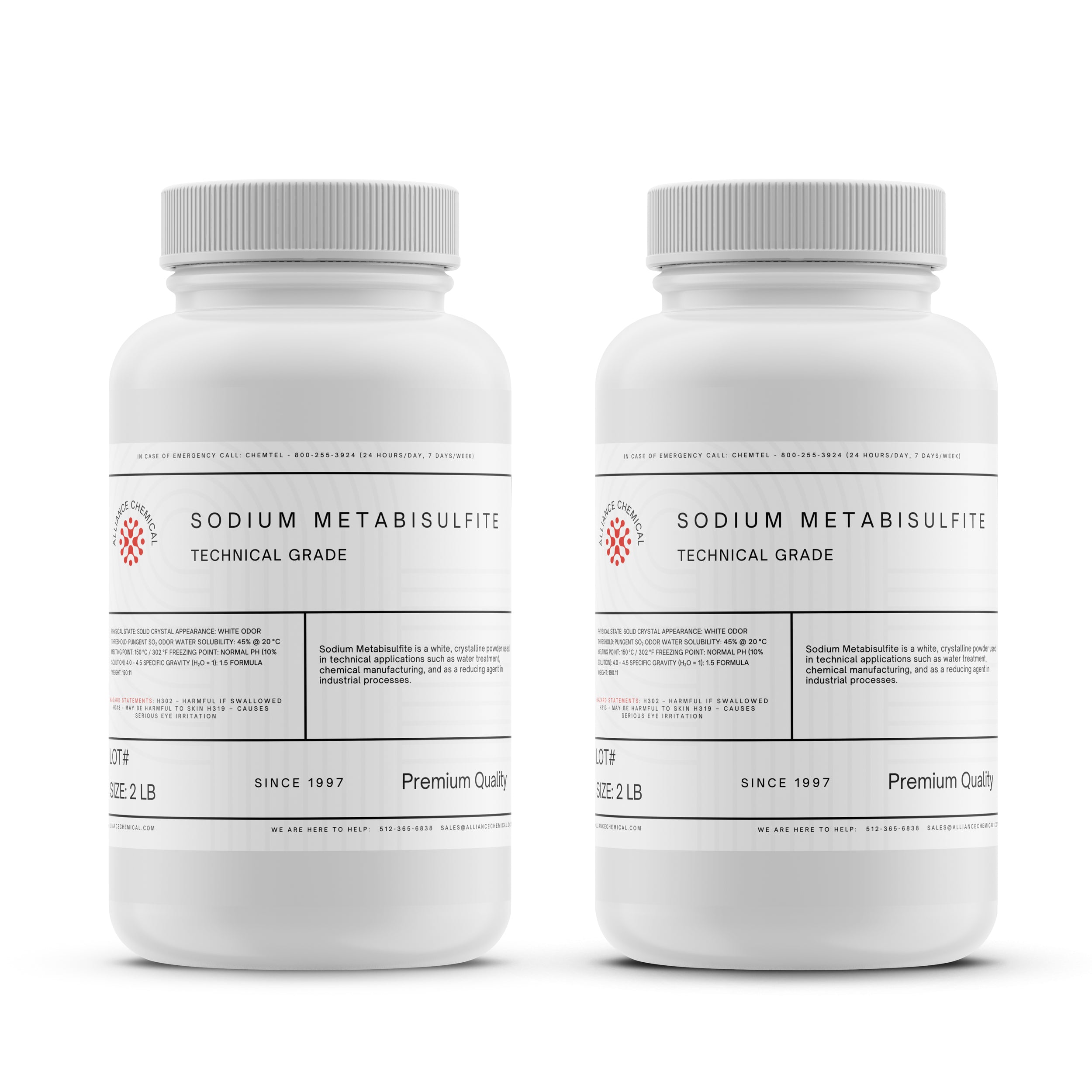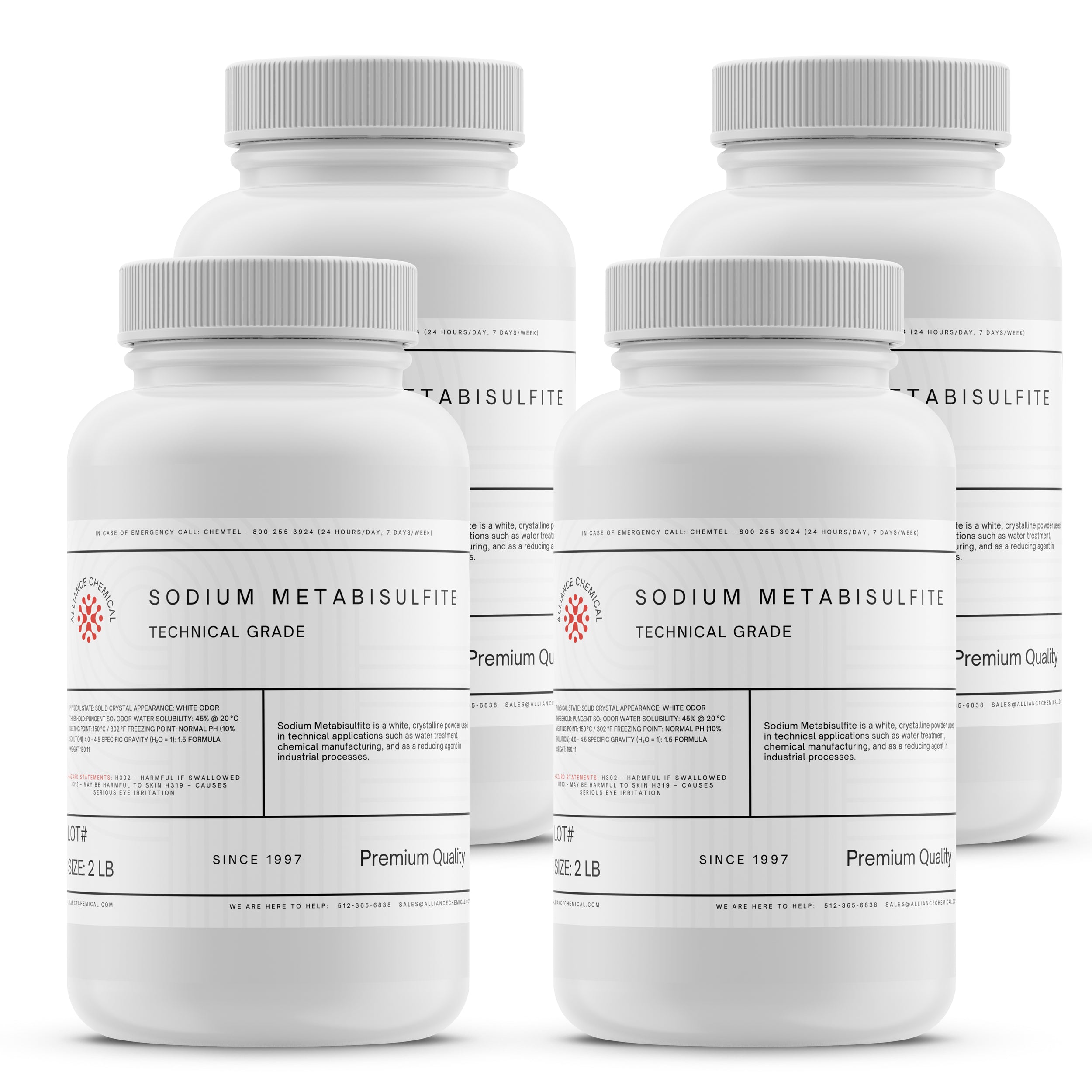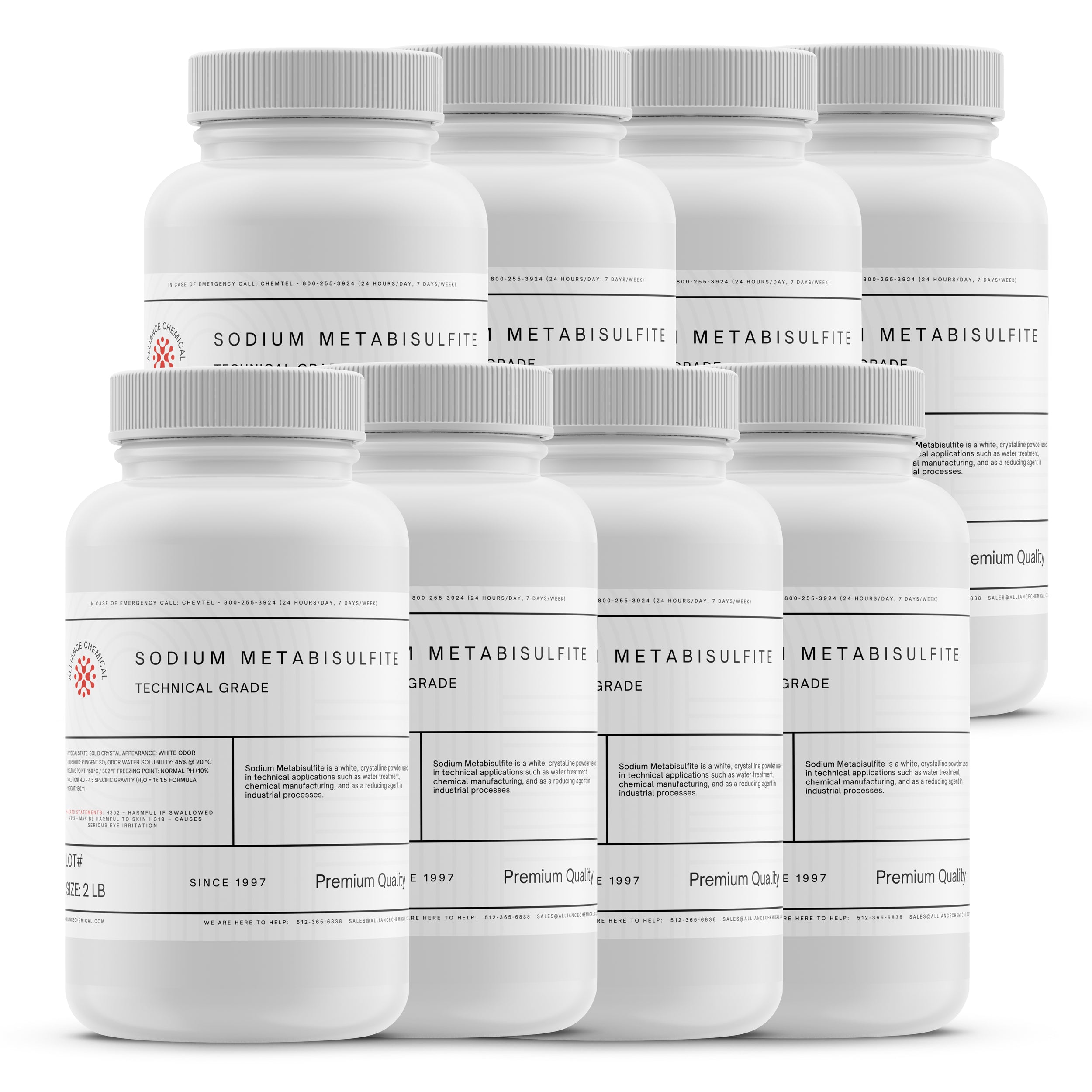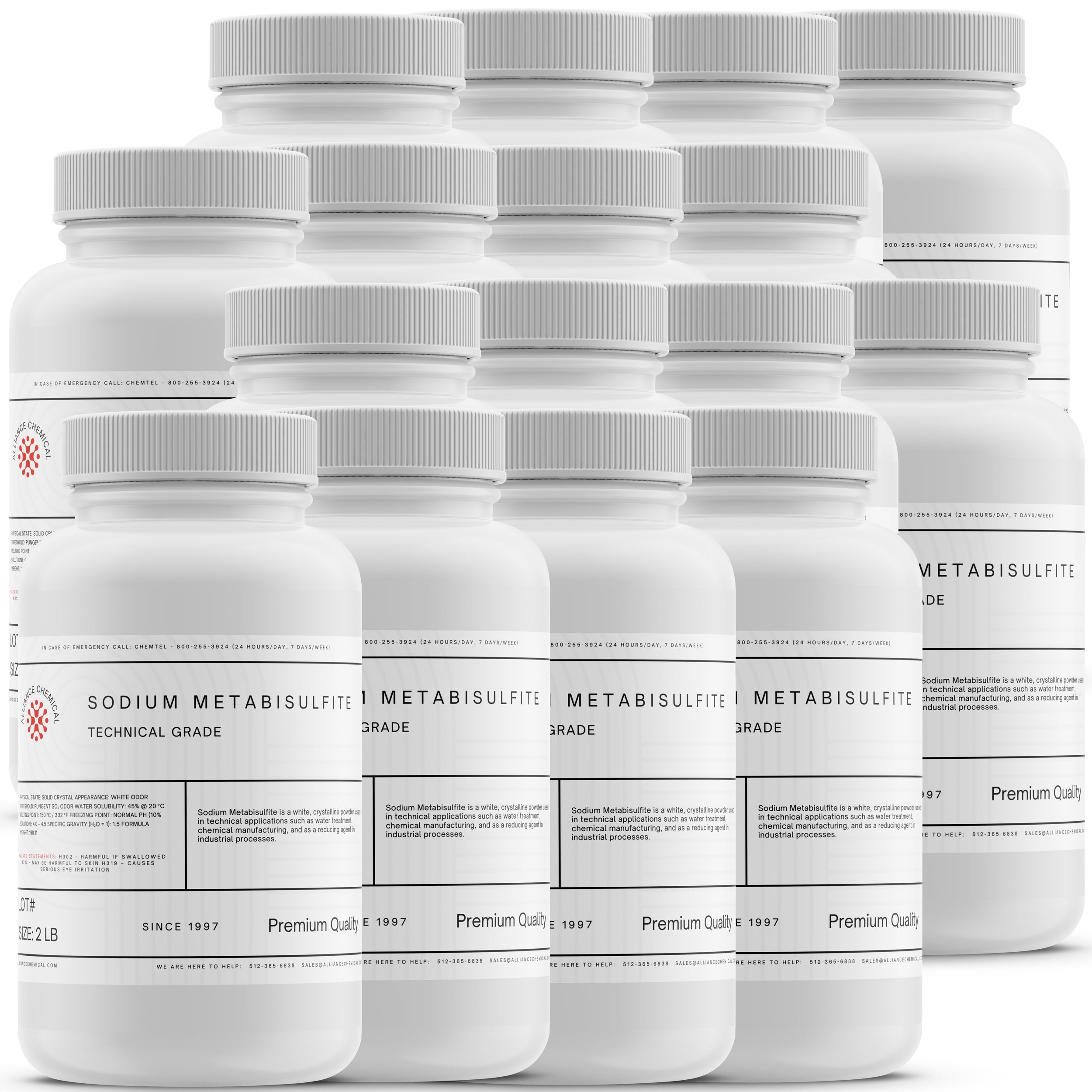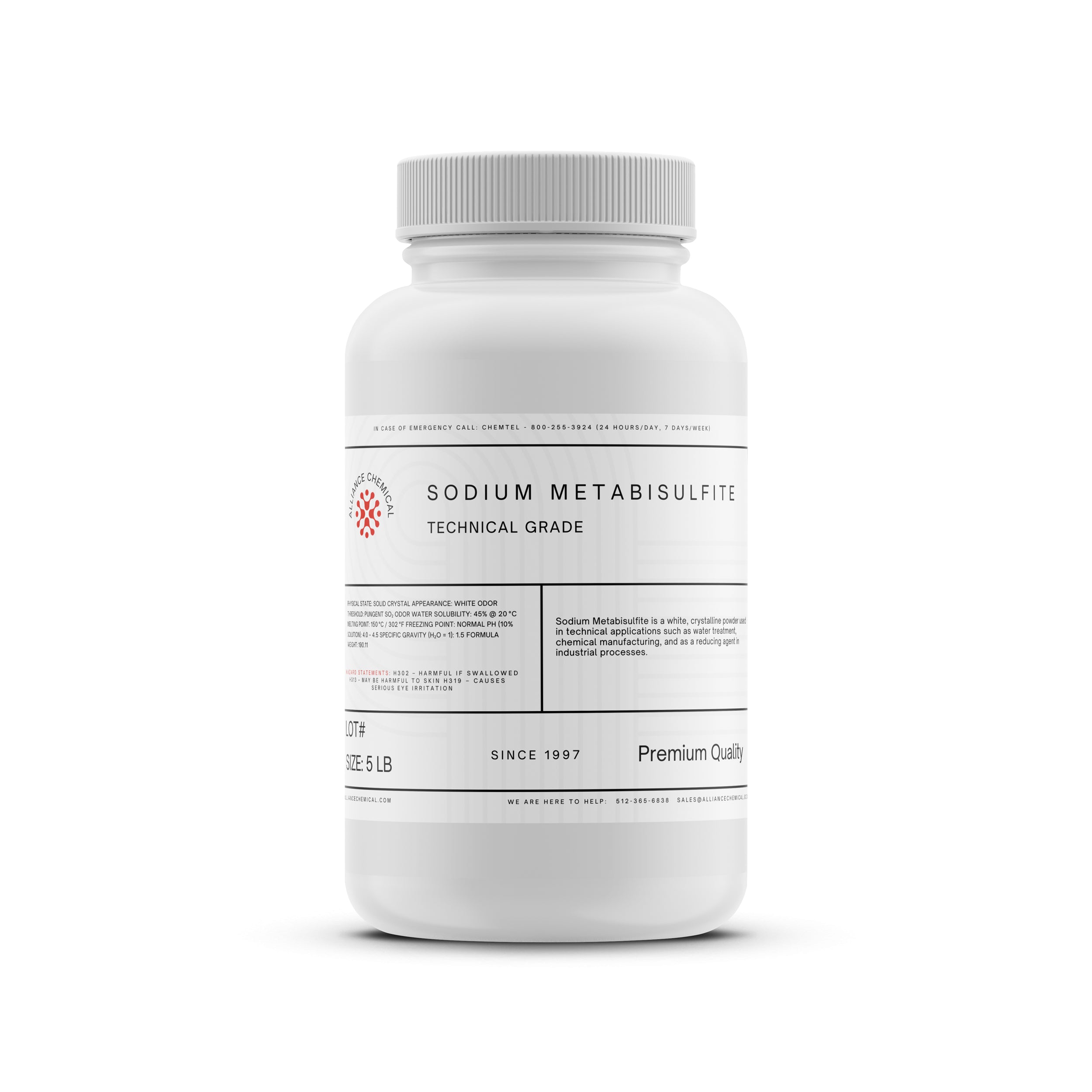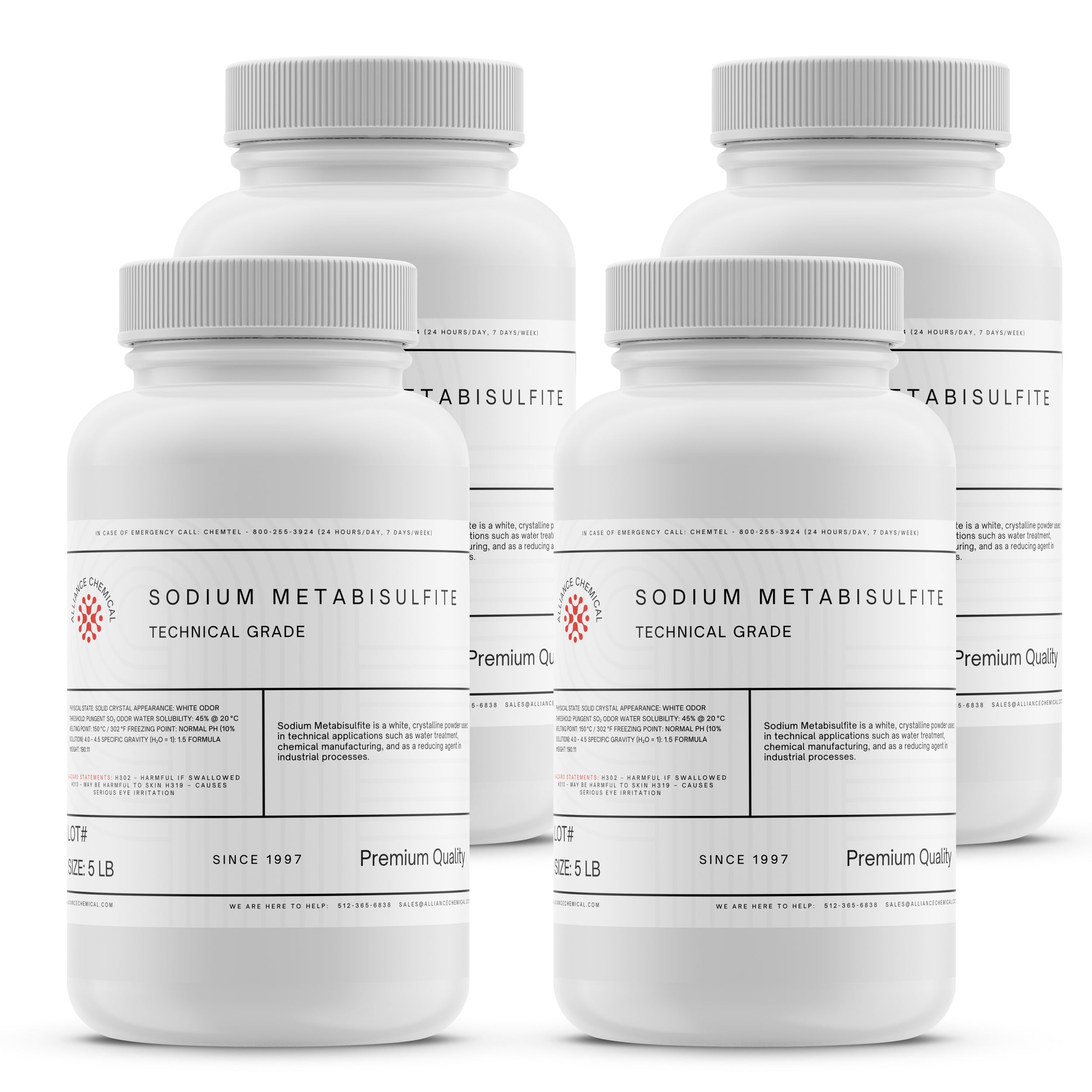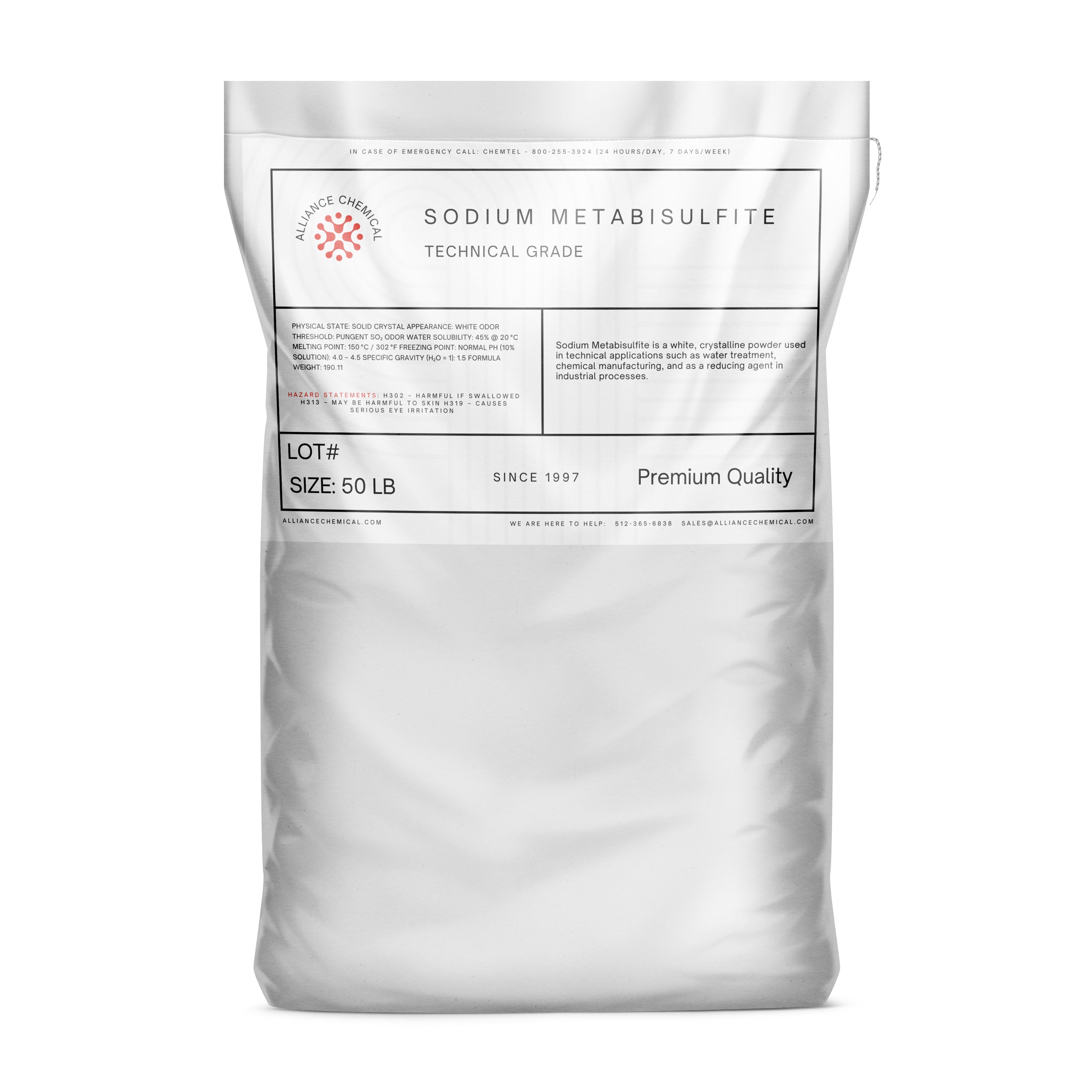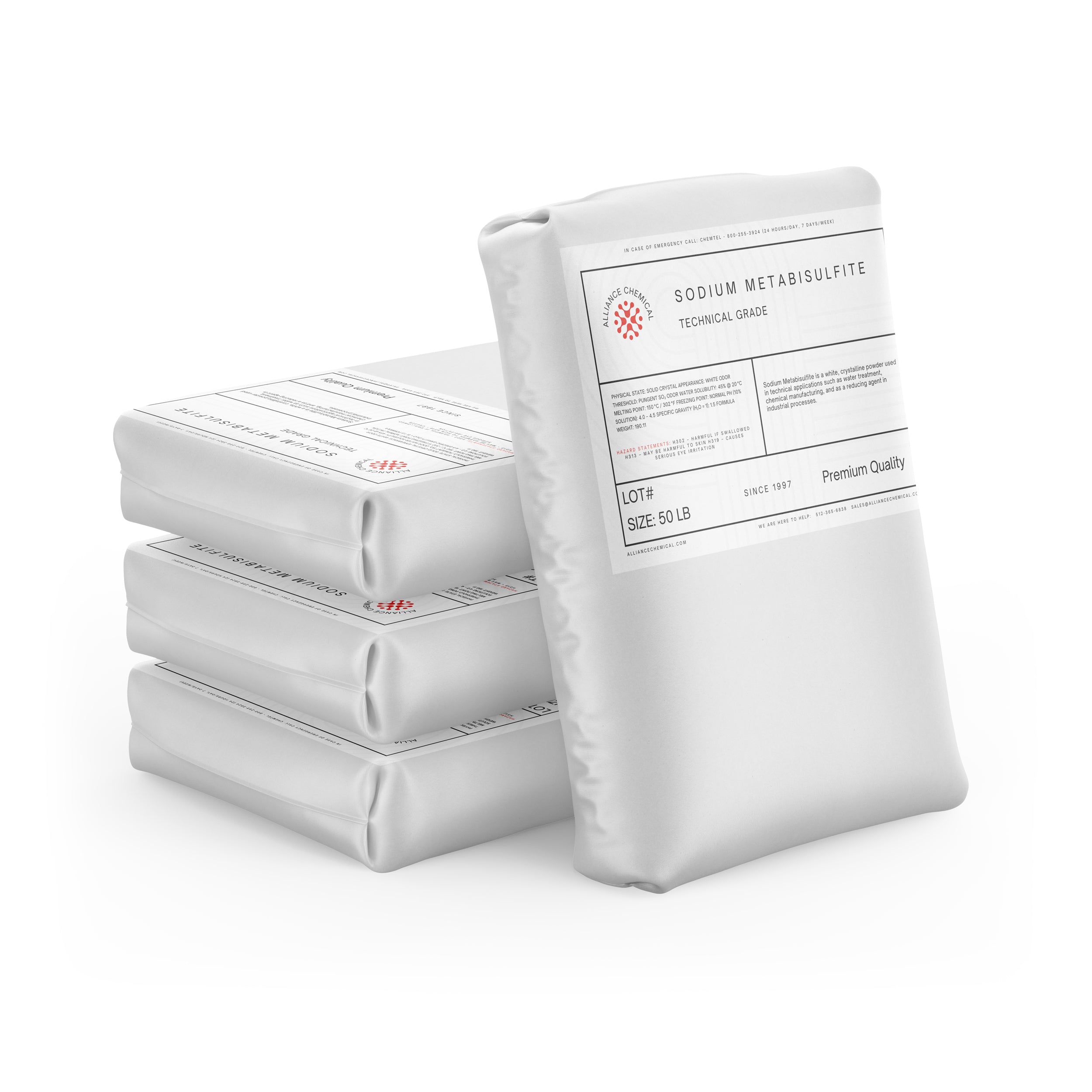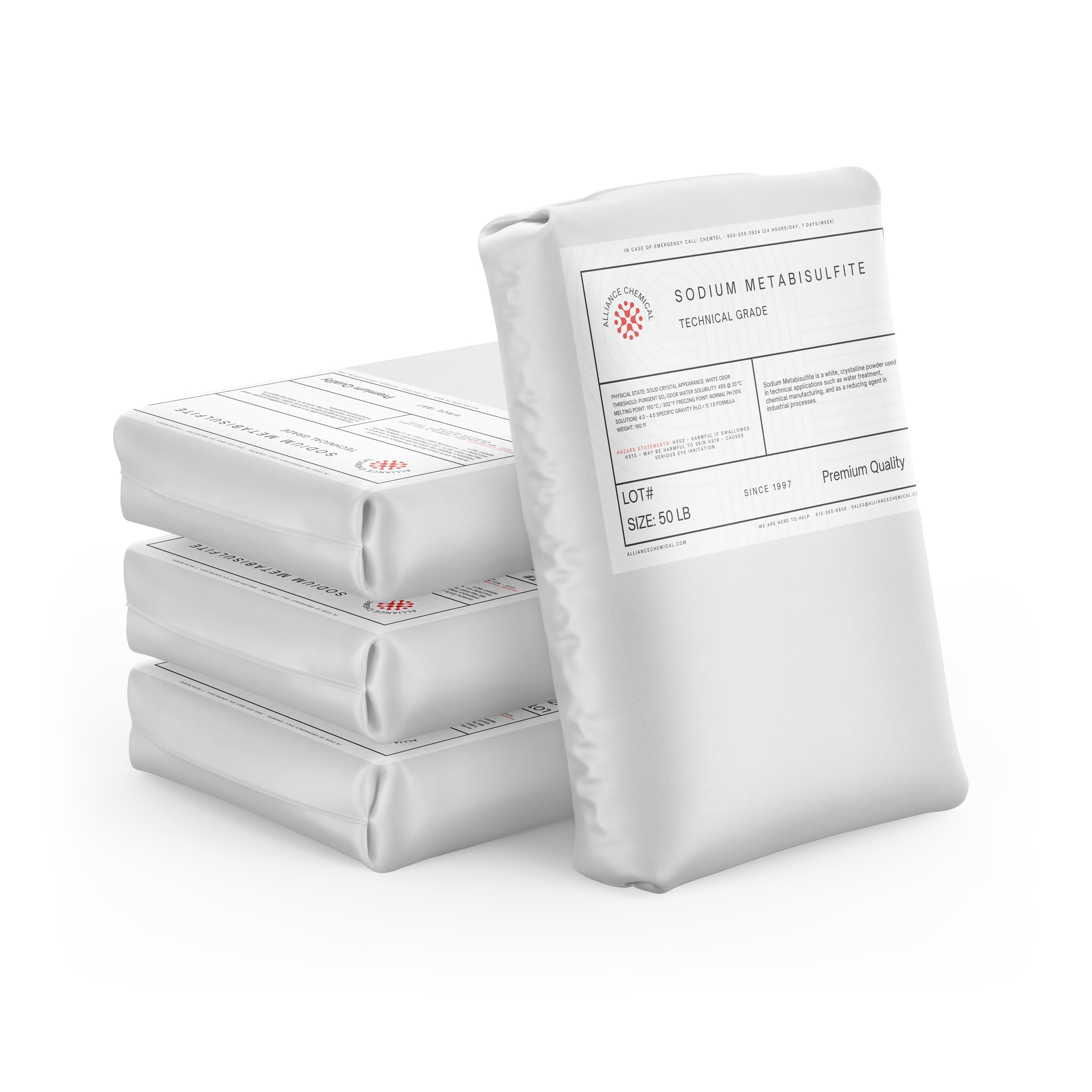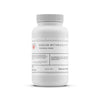Sodium Metabisulfite - Technical Grade
$25.00
Unit price
Quantity
Ask a question
Product Overview
Sodium Metabisulfite – Technical Grade (Na₂S₂O₅) is a white crystalline powder that functions as a robust reducing agent and antioxidant across diverse industrial sectors. In water treatment, it efficiently reduces residual chlorine and other oxidants, contributing to safer process water and downstream corrosion control. Its preservative capabilities in food and beverage production help inhibit microbial growth and maintain product quality, while its reducing action is valuable in chemical synthesis and photographic development. This grade is designed for reliable performance under dry storage and standard manufacturing conditions, with compliance to USP-NF monograph expectations and stringent impurity controls to support regulatory and quality requirements in demanding environments.
With a high assay range (95–100% as Na₂S₂O₅, typical 98%) and low impurity levels, the product delivers predictable dosing and reproducible results in batch processes. It is supplied as a dry, free-flowing crystalline powder that dissolves readily in water to form a stable sulfite solution, suitable for integration into treatment trains, preservative formulations, and analytical workflows requiring precise reductive capability. Technical-grade specifications emphasize low heavy metal content and controlled chloride, sulfate, nitrate, and arsenic levels to meet industry standards and customer quality expectations.
Key Properties
- Appearance: White crystalline powder
- Chemical Formula: Na₂S₂O₅
- Molecular Weight: 190.11 g/mol
- CAS: 7681-57-4
- Assay (wt %): min 95, max 100; typical 98; Method: Titration with standardized NaOH
- Color (APHA/Hazen): max 15; typical 8; Method: APHA/Hazen visual comparison
- Specific Gravity (20°C): min 1.48, max 1.52; typical 1.50; Method: Hydrometer or pycnometer at 20°C
- Residue after Ignition: max 0.5%; typical 0.2%; Method: Gravimetric ignition at 550°C
- Chloride (Cl): max 25 ppm; typical 5 ppm; Method: IC or argentometric chloride titration
- Nitrate (NO₃⁻): max 25 ppm; typical 5 ppm; Method: Ion Chromatography (IC)
- Ammonium (NH₄⁺): max 10 ppm; typical 2 ppm; Method: IC
- Sulfate (SO₄²⁻): max 100 ppm; typical 20 ppm; Method: IC
- Phosphate (PO₄³⁻): max 5 ppm; typical 1 ppm; Method: IC or colorimetric phosphate assay
- Arsenic (As): max 0.1 ppm; typical 0.02 ppm; Method: ICP-MS
- Heavy Metals (As, Pb): max 0.5 ppm; typical 0.1 ppm; Method: ICP-MS
- Iron (Fe): max 0.5 ppm; typical 0.05 ppm; Method: ICP-OES or ICP-MS
- Copper (Cu): max 0.5 ppm; typical 0.1 ppm; Method: ICP-OES
- Manganese (Mn): max 0.5 ppm; typical 0.1 ppm; Method: ICP-OES
- Nickel (Ni): max 0.5 ppm; typical 0.1 ppm; Method: ICP-OES
- Lead (Pb): max 0.5 ppm; typical 0.1 ppm; Method: ICP-OES
- Zinc (Zn): max 1 ppm; typical 0.2 ppm; Method: ICP-OES
- Aluminum (Al): max 2 ppm; typical 0.5 ppm; Method: ICP-OES
- Chromium (Cr): max 1 ppm; typical 0.2 ppm; Method: ICP-OES
- Cobalt (Co): max 0.5 ppm; typical 0.1 ppm; Method: ICP-OES
- Calcium (Ca): max 50 ppm; typical 10 ppm; Method: ICP-OES
- Magnesium (Mg): max 40 ppm; typical 8 ppm; Method: ICP-OES
- Potassium (K): max 25 ppm; typical 5 ppm; Method: ICP-OES
- Sodium (Na): max 100 ppm; typical 20 ppm; Method: ICP-OES
- pH-related Notes: pH range is critical for stability in aqueous solutions
- Solubility: Soluble in water; insoluble in organic solvents
- Melting Point: 176°C
- Density: 1.48 g/mL (25°C)
- Conformance: Meets USP-NF Monograph
Common Applications
- Water Treatment: Used as a reducing agent to dechlorinate and control oxidants in process water and municipal water systems, enabling downstream corrosion control and improved water quality.
- Food Preservative: Acts as an antioxidant and preservative to inhibit microbial growth in various food and beverage formulations, supporting shelf stability and color retention.
- Photography Developer: Utilized in photographic development to regulate oxidation and maintain image integrity through controlled reducing conditions.
- Chemical Synthesis: Serves as a reducing agent in multiple synthetic pathways, enabling selective reactions and higher yields in chemical manufacturing.
- Textile Industry: Employed in dyeing and finishing processes to adjust reducing environments, promote uniform color development, and improve fabric quality.
- Paper Production: Used in pulping and pretreatment steps to manage oxidation levels and preserve pulp integrity during processing.
- Mineral Processing: Acts as a reductant in certain leaching and mineral processing workflows to optimize metal recovery.
Safety Precautions
During handling and storage, use appropriate PPE including chemical goggles or faceshield, chemical-resistant gloves, and lab coats or coveralls. Maintain containers in a cool, dry, well-ventilated area away from moisture and incompatible materials. Keep containers tightly closed and prevent exposure to moisture, which can cause clumping and degradation. Use ventilation to control dust and avoid inhalation of powder dust; avoid ingestion and direct skin contact.
Emergency procedures include rinsing skin with plenty of soap and water if contact occurs, flushing eyes with water for several minutes and seeking medical attention for irritation, and moving to fresh air if inhaled and symptoms persist. In the event of ingestion or significant exposure, contact poison control or a medical professional immediately. Store and handle in accordance with OSHA guidelines and follow the SDS for specifics on first aid, spill response, and exposure controls. Transport as UN 3260, Corrosive solid, n.o.s., Class 8, PG III.
Benefits
✔ High Purity and Low Impurity Profile – Tight specification control reduces variability in dosing and downstream process performance.
✔ Regulatory Compliance – Meets USP-NF monograph expectations and maintains compatibility with food and water treatment standards with strict heavy metal limits.
✔ Stable in Dry Form – Dry, free-flowing powder minimizes caking and simplifies handling in bulk storage and feed systems.
✔ Versatile Reducing Agent – Effective in water treatment, chemical synthesis, and dyeing processes, enabling controlled oxidation states and efficient reactions.
| Property | Value |
|---|
Compare Products
| Price |
|---|
| SKU |
| Rating |
| Discount |
| Vendor |
| Tags |
| Weight |
| Stock |
| Short Description |

